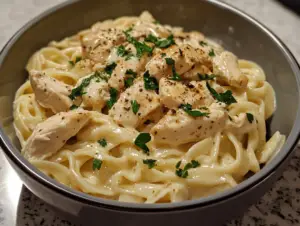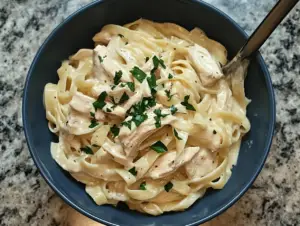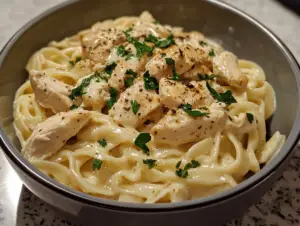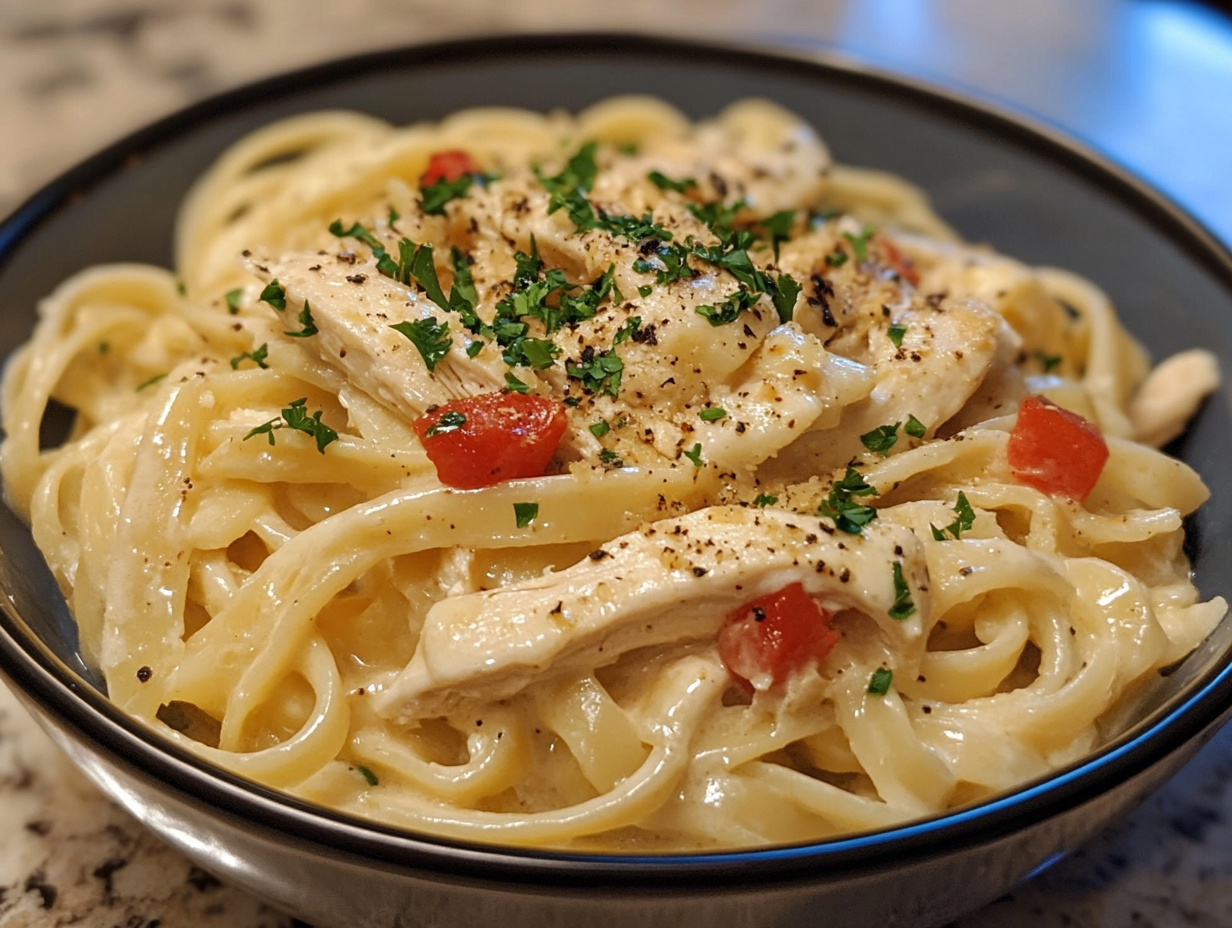Chicken Alfredo is a beloved comfort food that combines creamy sauce, tender chicken, and hearty pasta. But for those who are conscious of their diet, the big question arises: how many calories are in a bowl of homemade Chicken Alfredo? In this detailed article, we’ll dive deep into the calorie content, nutritional facts, and healthier alternatives to help you enjoy this delicious dish without the guilt.
What Influences the Caloric Content of Chicken Alfredo?
When it comes to homemade Chicken Alfredo, various factors can influence the total calorie count, including:
- Portion size: Larger portions significantly increase calorie intake.
- Ingredients: Using heavy cream, butter, and high-fat cheeses can push the calorie count upward.
- Preparation method: Adding oils or different cooking techniques may also impact the caloric content.
A standard cup of Chicken Alfredo can contain approximately 650 calories. However, this number varies based on the ingredients and portion size used in the recipe.
Learn more about the effects of saturated fats on overall health.
Understanding the Nutritional Breakdown of Chicken Alfredo
Let’s break down the nutritional content of a standard 1-cup serving of homemade Chicken Alfredo:
- Calories: 650
- Total Fat: 29.75g (42% of daily value)
- Saturated Fat: 15.47g
- Trans Fat: 0g
- Carbohydrates: 55.79g (34% of daily value)
- Protein: 37.99g (24% of daily value)
- Sodium: 763mg (33% of daily value)
- Cholesterol: 118mg (39% of daily value)
Chicken Alfredo is high in calories, primarily due to its fat and carbohydrate content, making it a dish that should be enjoyed in moderation.
For a more detailed look at the nutritional composition, visit this resource.
Variations in Calorie Content Based on Portion Size
Not all servings of Chicken Alfredo are created equal. The size of the portion you serve can drastically affect the total calorie count. Here’s a quick look at how different portion sizes impact calorie intake:
- 1 oz of Chicken Alfredo: 72 calories
- 100g of Chicken Alfredo: 255 calories
- 1 cup of Chicken Alfredo: 650 calories
Understanding portion control can help you manage your calorie intake while still enjoying your favorite dishes.
The Role of Fats in Chicken Alfredo

The fat content in Chicken Alfredo is one of the primary contributors to its high calorie count. With nearly 30 grams of total fat per serving, most of it comes from the cream, butter, and cheese that give Alfredo its creamy texture. Particularly concerning is the 15.47 grams of saturated fat, which can raise cholesterol levels and increase the risk of heart disease.
Ways to Reduce Fat Content:
- Substitute heavy cream with half-and-half or low-fat milk.
- Reduce the amount of butter used by swapping some of it for olive oil, which provides healthier fats.
- Use a reduced-fat or part-skim Parmesan cheese.
By making these adjustments, you can still enjoy the rich texture of Alfredo sauce while cutting down on unhealthy fats.
Carbohydrates in Chicken Alfredo
Carbohydrates in Chicken Alfredo primarily come from the pasta. A typical serving contains about 55 grams of carbs, which can contribute to weight gain if not balanced with other nutrients. For those on low-carb diets, this amount can be problematic.
Strategies for Lowering Carbohydrate Intake:
- Opt for whole wheat pasta to increase fiber content and slow down digestion.
- Try low-carb pasta alternatives such as zucchini noodles (zoodles) or shirataki noodles, which can significantly reduce the carbohydrate content.
- Reduce the portion size of pasta and increase the chicken and vegetable content in the dish to balance out the carbs.
The Benefits of Protein in Chicken Alfredo
One of the redeeming qualities of Chicken Alfredo is its high protein content. Chicken provides a lean source of protein, which is essential for muscle growth, tissue repair, and overall body maintenance. With nearly 38 grams of protein per serving, this dish can be a great option for those looking to build or maintain muscle mass, especially post-workout.
Why Protein is Important:
- Supports muscle repair and growth after physical activity.
- Keeps you fuller longer, which can help with weight management.
- Boosts metabolism due to the thermic effect of protein, which means your body burns more calories digesting protein compared to fats or carbs.
To further boost the protein content, consider adding more chicken or using leaner cuts of meat like chicken breast.
Sodium and Cholesterol Concerns in Chicken Alfredo
Sodium and cholesterol levels in Chicken Alfredo are other health aspects to consider. With 763mg of sodium and 118mg of cholesterol per serving, this dish can contribute to high blood pressure and increased cholesterol levels if eaten regularly. The high sodium content can also lead to water retention and bloating, which may make you feel uncomfortable after eating.
Tips for Reducing Sodium and Cholesterol:
- Use low-sodium chicken broth in place of regular broth or cream to reduce sodium levels.
- Avoid adding additional salt while cooking.
- Choose lean cuts of chicken like skinless chicken breasts to reduce cholesterol.
For a deeper understanding of how sodium affects your health, refer to this guide.
Making a Healthier Homemade Chicken Alfredo

If you’re trying to enjoy Chicken Alfredo while being mindful of your calorie intake, there are several ways to make this dish healthier without sacrificing taste.
Healthy Ingredient Substitutions:
- To make Chicken Alfredo healthier without losing its creamy and satisfying taste, consider these ingredient substitutions:
- Low-fat milk instead of heavy cream: Replace heavy cream with low-fat milk or even evaporated skim milk to drastically cut down on calories and fat while maintaining a creamy texture.
- Greek yogurt in place of cream: For a protein-rich, low-fat alternative, use plain Greek yogurt. It adds creaminess while boosting the protein content and reducing fat.
- Whole wheat pasta instead of regular pasta: Whole wheat pasta is higher in fiber and nutrients, helping you feel fuller longer and improving digestion.
- Zoodles (zucchini noodles) or spaghetti squash: Replace pasta entirely with spiralized zucchini or cooked spaghetti squash for a low-carb, gluten-free alternative that’s rich in vitamins and fiber.
- Olive oil instead of butter: Substitute butter with olive oil to introduce healthier fats (monounsaturated fats) and reduce saturated fat in the dish.
- Reduced-fat Parmesan cheese or nutritional yeast: Use a lighter version of Parmesan or nutritional yeast to mimic the cheesy flavor while cutting down on fat and calories.
- Lean chicken breast instead of chicken thighs: Chicken breasts are lower in fat and calories compared to thighs but still provide a great source of protein.
Healthier Cooking Techniques:
- To enjoy Chicken Alfredo without the guilt, here are some healthier cooking techniques that will lower calories and fat while maintaining the dish’s delicious flavor:
- Grill or bake the chicken: Instead of frying the chicken in oil or butter, opt for grilling or baking. This reduces the overall fat content while still keeping the chicken flavorful and tender.
- Use olive oil instead of butter: Swap out some or all of the butter with olive oil. Olive oil provides healthier fats (monounsaturated fats) and can still give the sauce a creamy texture.
- Steam or lightly sauté vegetables: Add nutrient-rich vegetables like spinach, broccoli, or mushrooms to your Alfredo sauce. Lightly sautéing or steaming them keeps their nutrient content intact and adds bulk to the dish without significantly increasing calories.
- Reduce the cream and cheese: Try cutting the amount of cream and cheese in half, replacing some of the cream with low-fat milk or using a lighter version of cheese. This simple swap lowers the fat and calorie count without sacrificing the Alfredo flavor.
- Blend cauliflower for a creamy sauce: A fantastic low-calorie alternative to cream, blend steamed cauliflower with a bit of broth and a touch of Parmesan. This creates a smooth, creamy base for the Alfredo sauce with significantly fewer calories.
Frequently Asked Questions (FAQs)
How Many Calories Are in a Serving of Chicken Alfredo with Different Pasta Types?
The calorie count in Chicken Alfredo will vary depending on the type of pasta used. For instance, whole wheat pasta may have slightly more fiber but similar calorie content compared to traditional pasta. On the other hand, using low-carb alternatives like zucchini noodles or shirataki noodles can drastically reduce the calorie count.
Is Homemade Chicken Alfredo Healthier Than Restaurant Versions?
In most cases, yes. Homemade Chicken Alfredo is generally healthier because you have complete control over the ingredients used. Restaurant versions often contain more butter, cream, and cheese, resulting in higher calorie, fat, and sodium content. By preparing it at home, you can adjust the recipe to suit your dietary needs.
What Is the Best Way to Reduce Calories in Chicken Alfredo?
The easiest way to reduce calories is by making substitutions for high-calorie ingredients. For example, using low-fat milk instead of heavy cream, lean chicken breasts, and whole wheat pasta can cut the calories significantly. You can also control portion sizes to reduce calorie intake per serving.
Is Chicken Alfredo Suitable for Weight Loss?
Chicken Alfredo can be part of a weight-loss diet, but only if you control portion sizes and make healthy substitutions. Reducing the amount of cream and butter in the recipe or replacing pasta with low-carb alternatives like zucchini noodles can help lower the calorie content, making it a more weight-loss-friendly option.
How Can I Calculate the Calories in My Homemade Chicken Alfredo?
To calculate the calories in your homemade Chicken Alfredo, add up the calories of each ingredient used in your recipe. Use a kitchen scale to measure the weight of your ingredients and refer to nutritional labels for accurate calorie counts. Online calorie calculators can also help streamline this process.

Conclusion
Chicken Alfredo is a rich, delicious dish that can be enjoyed in moderation. While the traditional recipe can be high in calories, fat, and sodium, making some simple adjustments to the ingredients and portion sizes can significantly reduce its calorie count and improve its nutritional profile.
By incorporating healthier alternatives such as low-fat dairy, whole wheat pasta, or zoodles, and focusing on lean proteins like chicken breast, you can make this dish a part of a balanced diet without compromising on flavor. Enjoying Chicken Alfredo as a special treat rather than a regular meal can help you maintain a healthier lifestyle while still indulging in your favorite comfort foods.

